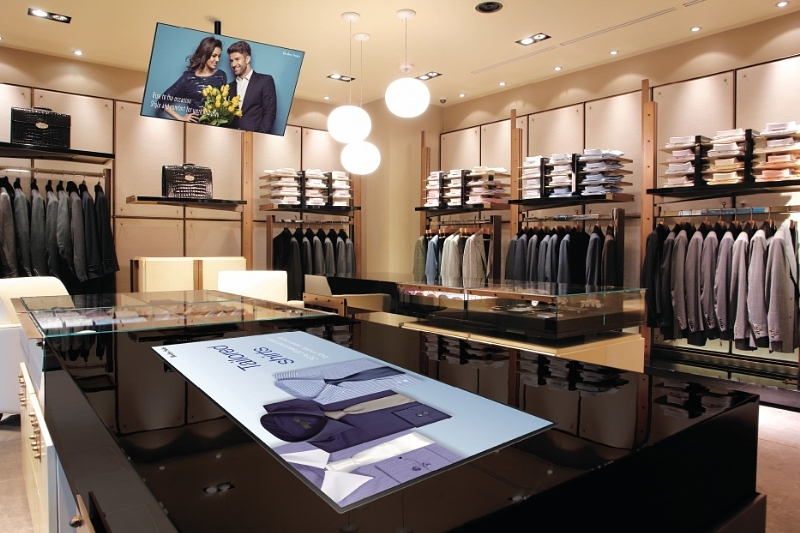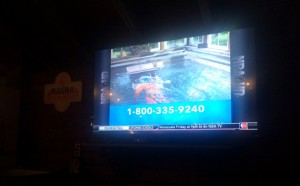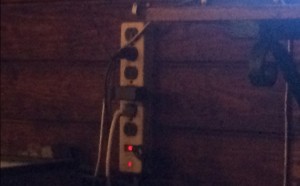by Corinne Furmanek O’Rawe | Apr 10, 2017 | Digital Signage, Pro Displays, Video Walls
When we live on the east coast, the spring thaw sends thoughts of basking in the summer sun at a lake front cottage.
And then it hits you! THINK THIN! Who wouldn’t want to be the thinnest model ever?
You don’t need to go on a stringent diet or work out to the point of exhaustion. LG can help! That’s right; LG has released its futuristic “wallpaper” OLED TV – Their thinnest model ever! This panel is so thin and light, you can literally attach the screen directly to the wall. Making it seem more like a framed painting than cutting-edge OLED technology, this is first-of-its-kind design.
Most models sold today require a backlight, but not LG OLED TVs. LG OLED TVs have complete control over their pixels. Meaning they can be turned on or off to achieve truly perfect black levels with zero light bleed. This gives shadows more depth and makes colors feel like they’re leaping off the screen.
This version of the LG OLED Wallpaper is specifically for commercial display applications and it’s in a 55″ form-factor that weighs less than 13 pounds and has a depth that is just 3.65 millimeters (0.14 inches). Yes, you read that right – barely more than 1/10th of an inch.
LG OLED technology uses self-lighting pixels for exact control of image brightness and quality, and with no separate light source the technology is extremely lightweight, thin and flexible
Rave Publications highlighted the new LG OLED Wallpaper Display in a recent article written by Gary Kayye, highlighting the best new products at 2016 Digital Signage Expo.
“The Wallpaper display can be mounted either vertically or horizontally for a customizable display design. Ultra-slim mounting brackets with a magnetic mat create a truly seamless design that becomes one with the wall. Electronic components are housed in a separate control box connected to the display with a 2-meter (6-1/2-foot) cable.”
So if you are looking for a solution with perfect color, a wide viewing angle, and clear viewing images, check out the LG 55EJ5C. And, with easy installation and video wall tiling options, it can be hung on the wall with dedicated slim brackets for video wall usage; providing you more time to spend basking in the sun at that lakeside cottage.
by John Wills | Jan 24, 2017 | Digital Signage, Pro Displays, Uncategorized
Not being a software developer, you can imagine my confusion when NEC Display Solutions of America announced its upcoming line of commercial displays with the ability to insert a Raspberry Pi Compute Module.
“Raspberry Pi?” I said. “Isn’t that some sort of dessert?”
Raspberry Pi was developed in the UK by the Raspberry Pi Foundation in 2012. The Foundation’s original intention was to provide an inexpensive tool for the teaching of basic computer science in schools and in developing countries. But like many inventions, the original model became far more popular than anticipated, spreading into many other commercial uses.
As I continued my inquiry, I was informed that the Raspberry Pi Compute Module is a tiny PC that looks like a small board of laptop memory. First introduced in 2014, it’s basically a small alternative to a full-sized Raspberry Pi computer (which is only about the size of a credit card).
The upcoming line of NEC V-Series and P-Series displays will have screen sizes ranging from 40 to 80 inches, and use a Pi Compute Module to power digital signage and other applications. There’s an internal bay in each display that will accept either a first-gen Raspberry Pi Compute Module or recently-introduced Compute 3 Module. These new displays are due to ship in Q2 2017 and will be available from Almo ProAV.
So, how will the NEC displays with the Raspberry Pi module (which, by the way, is making my stomach growl right now), be used? Well, in addition to powering digital signage applications, the Raspberry Pi Foundation envisions NEC displays being used for interactive presentations and other Internet of Things applications. Oh, oh….there’s that “IoT” talk again…
How does this benefit YOU?
Bottom line, is that with Raspberry Pi, software application developers and digital signage content creators now have many flexible and scalable platforms to choose from. All this new world of capabilities inserts into an elegant design of displays suitable for smooth installations in any environment. No more external media players or PCs with every display. Can you imagine the power savings and ease of installation? So ask yourself Mr. Digital Signage Integrator, are you embracing this powerful platform to offer your end-users innovation? Take a bite of the Pi!
“Our strategic initiative to team up with Raspberry Pi is an example of how we continue to ensure that an organization in any sector has the most advanced technology in place to meet their application needs. Our open platform approach provides display intelligence at any time, thanks to our modular and interchangeable design. Integrating the Raspberry Pis with our displays will provide businesses with advanced technology suitable for digital signage, streaming and presenting to enhance the overall visual experience at an affordable price point,” said Stefanie Corinth, Senior Vice President Marketing and Business Development at NEC Display Solutions Europe GmbH.
And as contributor Bob Raikes stated three months ago in Display Daily, “I see this as quite an elegant solution for NEC. The company is not in the TV business, unlike competitors that are in the digital signage business like Samsung, LG and Philips, so it has not had the economies of scale to simply exploit technology developed for Smart TVs, as the others have been able to do. By adopting Pi, NEC is able to exploit the volume of the Pi to keep costs relatively down (the older Compute Module is currently selling for less than $30) and offer a level of price and performance that is competitive”
We are working with our Almo Content Services partners to take advantage of this new and exciting offering from NEC. There are many emerging content creation software offerings written for the Raspberry Pi platform and we plan to offer our integrators and dealers the latest in innovative and interactive digital signage.
I invite you to write me and let me know about your taste for Raspberry Pi. I’ll be happy to post your comments on future posts as this exciting combination of NEC displays and Raspberry Pi content is introduced into the US digital signage marketplace.
So, if Raspberry Pi is on the panel menu, I’ll have one with my cappuccino, please!
by Heather Wagaman | Nov 1, 2016 | Digital Signage, Education, Uncategorized
October finished up the last of the Almo Pro AV E4 AV Tours for 2016, the last of which was in Dallas, TX.
One of the many things to do is walk through the Exhibit Hall, where all of Almo’s manufacturer partners showcase their latest and greatest products…
I really “flipped” over the all-new R Series product displayed by Sharp at our Dallas Show.

 This beauty will come in a 42”, 49” and 55” display, and with the extreme tilt capabilities opens up new mounting possibilities that gives more flexibility than ever before to digital signage installations. My imagination went wild. Not only can this series be mounted in portrait or landscape mode, imagine the 42” display mounted face up on a table in a sleek apparel shop, or the 55” face down from the ceiling in a planetarium…
This beauty will come in a 42”, 49” and 55” display, and with the extreme tilt capabilities opens up new mounting possibilities that gives more flexibility than ever before to digital signage installations. My imagination went wild. Not only can this series be mounted in portrait or landscape mode, imagine the 42” display mounted face up on a table in a sleek apparel shop, or the 55” face down from the ceiling in a planetarium…
While I wouldn’t suggest mounting it on a floor surface that would be walked on, the design of these monitors is robust enough that they can be suspended from the four corners of the rear housing using wires. I immediately envisioned a simple, elegant look for an office lobby, like an attorney’s office or accounting firm or a retail shop where information, daily specials or other content could be simply and beautifully displayed.
The ingenuity and creativity of our dealers and integrator customers is always impressive. And I can’t wait to see what they come up with when they let loose with Sharp’s new PN-R Series!
by Patricia Murkowski | Aug 22, 2016 | Digital Signage, Video Walls

Being in the Pro Av arena for 10 years there is really not much that I haven’t seen. You would think by now I wouldn’t be the person walking behind a LCD panel in a store or restaurant to see what mount is being used or what type of ceiling accessory it has…..well, you would be wrong! Yes, I am still that person! Just yesterday I received a text message with a picture from my niece while she was at Petco Stadium watching the Padres vs Diamondbacks game, instead of commenting on her experience my first response was “I love that stadium! I was part of their original AV renovation project in the early 2000’s”! Again, I am that person.
With that said, while there is not much in the AV arena I haven’t seen, there is still a TON that impresses me! Living in Chicago I have access to some of the most historic arenas and stadiums equipped with the best AV systems money can buy. Last month I had the privilege of going to the United Center to see Adele perform live. While I’ve been to the United Center numerous times over the last year, no other experience compared to this for me. I walk through the doors on July 13th and see the 35’ x 9’ curved video wall with no other than, yes, you guessed it, Adele! I was smiling from ear to ear and most definitely felt like a newbie in the AV industry. I am a huge fan. =)
 As with many sporting events and concerts, signage was everywhere! Visitors of the United Center can see 64, 42 inch flat panel displays throughout the 100 level concourses, not to mention LED boards inside each of the four main gate entrances.
As with many sporting events and concerts, signage was everywhere! Visitors of the United Center can see 64, 42 inch flat panel displays throughout the 100 level concourses, not to mention LED boards inside each of the four main gate entrances.
 I feel very lucky to be part of a great industry like Pro Av! I get to help clients spec in products that enhance their customers experience in many different vertical markets. On July 13th I was just a patron benefiting from a truly immersive fan experience thanks to innovative, Pro Av solutions.
I feel very lucky to be part of a great industry like Pro Av! I get to help clients spec in products that enhance their customers experience in many different vertical markets. On July 13th I was just a patron benefiting from a truly immersive fan experience thanks to innovative, Pro Av solutions.
by Melody Craigmyle | Aug 5, 2016 | Digital Signage, Pro Displays
I just returned from a much needed vacation in Puerto Rico at the Wyndham Rio Mar resort. This property recently completed a $500M addition of Wyndham vacation condos in partnership with his royal beach-iness and head Parrot, Jimmy Buffet. The Margaritaville themed portion of the resort was impressive and had that cool Buffet laid-back vibe. As a marketer, I’m amazed at how this artist, who hasn’t had a record on the charts in the last couple of decades (save collaborations Zac Brown and Alan Jackson), has managed to become a global brand commanding licensing agreements from everything to restaurants, merchandising and now resorts.
The outdoor cabana with swim up pool was the centerpieces of the resort, appropriately named Margaritaville. You even got your own mondo margarita cup shaped like, you guessed it, a blender!


Hanging above the bar was a gorgeous installation of SunBriteTV’s, made to withstand the heat, humidity, wind and sand rolling off the beach just a few feet away. Trust me when I say it’s humid down there and the TV’s looked fantastic. Note that the clock on the wall is always on 5 o’clock.

Fast forward a couple of evenings and we go to a beautiful restaurant that was completely open to the elements with a view to die for overlooking the ocean. We got there right before the sunset and ordered the sangria. I look over to my shoulder and there it is…the ultimate no-no in outdoor installations. It was Visio (cue the scary organ music!)

AND to top it off, it was plugged into a cheap power strip, totally exposed OVER AN ICE MACHINE! (Cue even scarier organ music) Can you say electrical fire/accident waiting to happen? Somebody call OSHA!!!!
|
We just had training from the very smart folks at SunBriteTV who reiterated that there are very real safety concerns with putting consumer TV’s outside. Forget about there being no warranty, or that the picture will be terrible in a matter of months, or that you can’t view those TV’s in direct sunlight. If you are working with a restaurant owner who wants to go on the cheap with his outdoor TV’s, tell him to call his insurance company and get a rider for electrocution for TV’s that aren’t UL certified for outdoor use. Maybe that will get him thinking. Business owners need peace of mind that their customers will be safe and happy. Use SunBriteTV and you can chill and go to your happy place – kind of like this…

by Corinne Furmanek O’Rawe | Jun 30, 2016 | Digital Signage, Pro Displays
 Choosing LG Supersign products is a smart and affordable way to provide an all-in-one display solution, with easy to use software for fast content creation. This all in one solution provides integrators entering the digital signage market a low cost option with simplicity. It is a great option for various verticals such as restaurants, financial institutions, dental and medical clinics, public offices, educational venues, retail stores and more.
Choosing LG Supersign products is a smart and affordable way to provide an all-in-one display solution, with easy to use software for fast content creation. This all in one solution provides integrators entering the digital signage market a low cost option with simplicity. It is a great option for various verticals such as restaurants, financial institutions, dental and medical clinics, public offices, educational venues, retail stores and more.
SO WHY SUPERSIGN?
- All in one slim and stylish solution
- 42 PRE MADE templates for multiple vertical markets
- Remote control over 50 TVs over the network
- Built-in tuner and speakers
- Multiple ports for multiple connection and applications
- 2 year warranty
SuperSign software includes a collection of basic templates to suit a variety of verticals. Details such as font, background color, accompanying image and the location of the video window can also be customized.
- SuperSign W Lite is a web-based content authoring/player solution that allow the connection of up to 50 client displays.
- SuperSign-W Lite has templates but is designed to build your own content from scratch by importing videos and jpg pictures and adding text zones.
- There are 74 predefined templates for use if preferred.
- SuperSign Simple Editor includes 42 pre-designed, ready-to-use content templates.
- SuperSign Simple Editor is designed as an easy way to create content.
- The 42 pre-defined Templates must be used as a starting point to build content.
- Check out the SuperSign-S tutorial video here
- SuperSign “C” for display control via network or RS-232, featuring enhanced auto calibration providing superior color adjustment in as little as 4 minutes per screen.
- SuperSign-C is not an application to create content. It is used for video wall calibration and RS232 (serial and network) control of LG monitors and Commercial lite TVs.
Although there are three downloadable versions, the most commonly required downloadable solution is the Supersign Simple Editor. You will easily recognize when to use SuperSign Simple Editor since the part numbers end with an “S”. Simple right?
5 Simple steps to setting up the LG Supersign product.
https://www.youtube.com/watch?v=H50dklAimAc
- Unbox the Unit
- Use the downloadable software to create your templates
- Set up the screens as to where you want to display the messages
- Upload the templates to the TV using a USB plug into the display, or run from a network media player
- Play and Loop
For more information, contact me or please visit: http://www.lg.com/us/commercial/display
Corinne O’Rawe | DSEG
Business Development Manager| Almo Professional A/V
P. 888-420-2566 x 6220 | C. 716-474-2323 | F.267-350-0321
website: www.almoproav.com


























